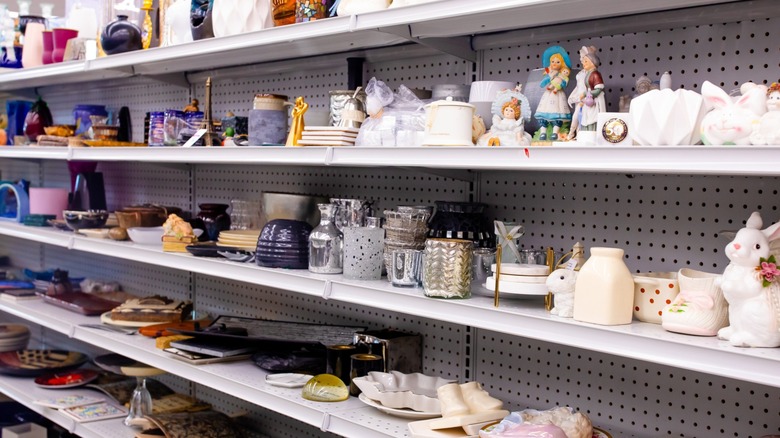Look For This Porcelain Pattern At The Thrift Store—it's Way More Valuable Than You Think
When you're perusing the aisles of your local thrift store, you might overlook the porcelain products, especially if you're not much of a tea drinker or uninterested in purchasing more dishware. Don't dismiss porcelain outright — you could be leaving some serious cash behind. If you find a plate or tea set with a "cobalt net" pattern, you might be looking at a Lomonosov Imperial Porcelain piece that can retail for thousands.
Never leave the thrift store without buying a Lomonosov Imperial Porcelain piece. The history of Lomonosov Imperial Porcelain begins in 1744 with the founding of the first porcelain factory in Russia. Since its founding, the company has been the go-to porcelain retailer for European nobility and continues to be highly sought after. Of all the patterns the company offers, which includes "winter night," "golden garden," and "Russian lubok," the cobalt net pattern is its most popular and distinct. The hand painted design uses blue paint derived from real cobalt salts as well as 22 karat gold accents, making each piece both unique and valuable. Brand new, a tea service in this pattern lists for around $2,000. On eBay, a secondhand set is selling for $800, and individual pieces can be found anywhere from $30 to $270. Not a bad return on investment for a thrift store find.
How to identify Lomonosov Imperial Porcelain (and avoid imitators)
Lomonosov Imperial Porcelain items can be some of the most valuable items you can find at a thrift store, but how do you know if the cup you picked up is the real deal or just a lookalike? The first sign is the beautiful and distinct cobalt net pattern, but the real sign of authenticity is the stamp on the bottom of each piece. Unfortunately, that matter is a bit complicated, as the stamp has changed multiple times in the almost 300 years since the factory's founding. Initially a state project overseen by Russia's Empress Elizabeth Petrovna, the factory was first known as Neva Porcelain Manufactory. The factory was renamed to the Imperial Porcelain Factory in the mid-19th century and the State Porcelain Works in 1917. Under the Soviet Union, it was known as the Leningrad Lomonosov Porcelain Works before becoming what it's known as today, the Lomonosov Porcelain Factory, in 1993.
During these different eras, the stamp has morphed as the venture evolved from a state project to a private joint-stock company, making it difficult for the layman to be sure their cobalt net piece is genuine. When it comes to authenticating your latest thrifting find, you have a few options. Antique websites like The Old Stuff offer examples of the factory stamp over different eras, and the official Lomonosov website provides side-by-side comparisons between imitation products and the originals. You can also contact Lomonosov Imperial Porcelain by email to have them authenticate your piece. Even if your find isn't an authentic product, it can still be a cute addition to your interior decor.

